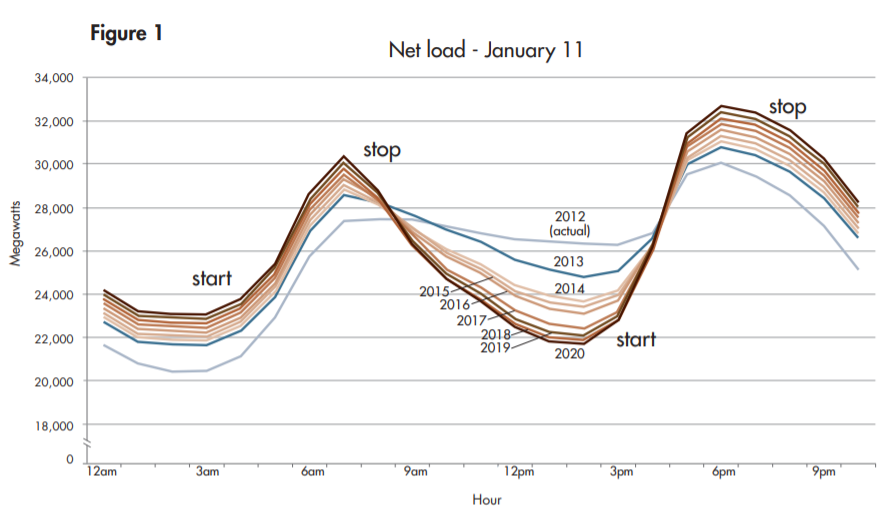How Solar Power Challenges Public Utilities
The United States has rejoined the Paris Accord. The world is pursuing aggressive Carbon Emissions goals by 2030. Daily, we get warnings that we are on a tipping point. So, why at this critical juncture are California public utilities lobbying to double solar power pricing? It leaves us wondering how solar power challenges public utilities
PG&E, So Cal Edison, and San Diego Gas & Electric are lobbying the California Public Utilities Commission (CPUC) to make consumer solar twice as expensive than it is today. This would put solar out of reach for the working and middle class, just when it is taking off.
The Duck Curve: Supply and Demand
In 2013 California Independent System Operator published a graph illustrating electricity demand versus available solar energy throughout the day. The graph was based on springtime solar power generation vs usage. Daily usage swings graphed in a swoop shaped like a duck and were christened the “duck curve”. The importance of the duck curve is its illustration of the disproportionate supply and demand of solar power.

During the day, when the sun shines, more solar power is produced than is used. In Minnesota, that excess power is routed to the utility grid and reused for other consumers. When the sun sets, and your solar grid isn’t producing power, you can buy back electricity from your electric company. If you have solar power storage batteries, your system can use the over produced electricity stored there.
The Effect of the Duck Curve
The fact that a system operator in California charted the transition point for solar energy is a sign that solar power is no longer a niche technology. Solar energy has moved into mainstream power production. However, there are some challenges faced in locations like California. The duck curve means California utility firms need to find the balance between power supply and demand. In the past, California has used curtailment of production, which wastes part of the power produced in solar farms. With better solar storage available today, more of that wasted power could be stored for use in evening hours when the solar panels are no longer converting sunlight to power.
Curtailment affects consumers because the waste reduces the economic benefits of using solar panels to produce solar power to run homes and businesses. The utility companies want to raise electricity prices to make up for the lost benefits. When one state does this, others may follow.
Complicated Modern Grid and Solar Storage
Modern electric grids are more complicated than they once were. There are various energy sources involved, such as solar, wind, and blue gas power generation, inverters and rooftop installations as well as microgrids.
The electric grid is divided into transmission and distribution systems. It allows power to be transported fair distances without losing much of it on high voltage power lines. The power is then distributed to homes and businesses on low voltage power lines. Substations and transformers convert the power from high to low voltage in order to deliver on demand.
Once electricity only flowed one way through the grids. Today, the grid needs to accommodate rooftop solar systems by handling two way electricity flow. Once the overproduction flows back to the electricity company, the consumer can buy back the electricity when their rooftop solar power system is not producing enough power for their demands.
Integrating storage technology with Solar power systems could also alleviate over generation followed by shortages of electricity during evening usage. The excess produced power can be stored in the solar power storage batteries, for use after the sun sets.
The Right Answer
The US Department of Energy Solar Energy Technologies Office is known as SETO. The goal of SETO is to support the safe integration of solar power systems into the nation’s electricity grid. Utility companies are learning how to adjust. Power demand has become predictable, as more consumers opt to convert to solar power for their homes and businesses. Electricity suppliers must continue to improve technology used to control the multidirectional power flow in the grid. Storage batteries, commercial and residential, will continue to gain favor for storing overproduced electricity until consumers can access and utilize it. Solar power challenges to public utilities will lead to better than ever efficiencies.
Renewable Solar Resources is a solar installation company in Plymouth Minnesota who loves educating consumers on solar advantages today. Every home that converts to solar as the primary electricity resource, saves roughly 1.6 metric tons of CO2 emissions each year. If you are ready to save money as you help achieve Paris Agreement emissions reduction, it could make sense for you to change to solar energy for your home or business. Visit https://renewable-solar.com or call (888) 432-9024 today and get the information you need to make your best decision. The energy audit is free and can help you start saving money – and energy – immediately.
